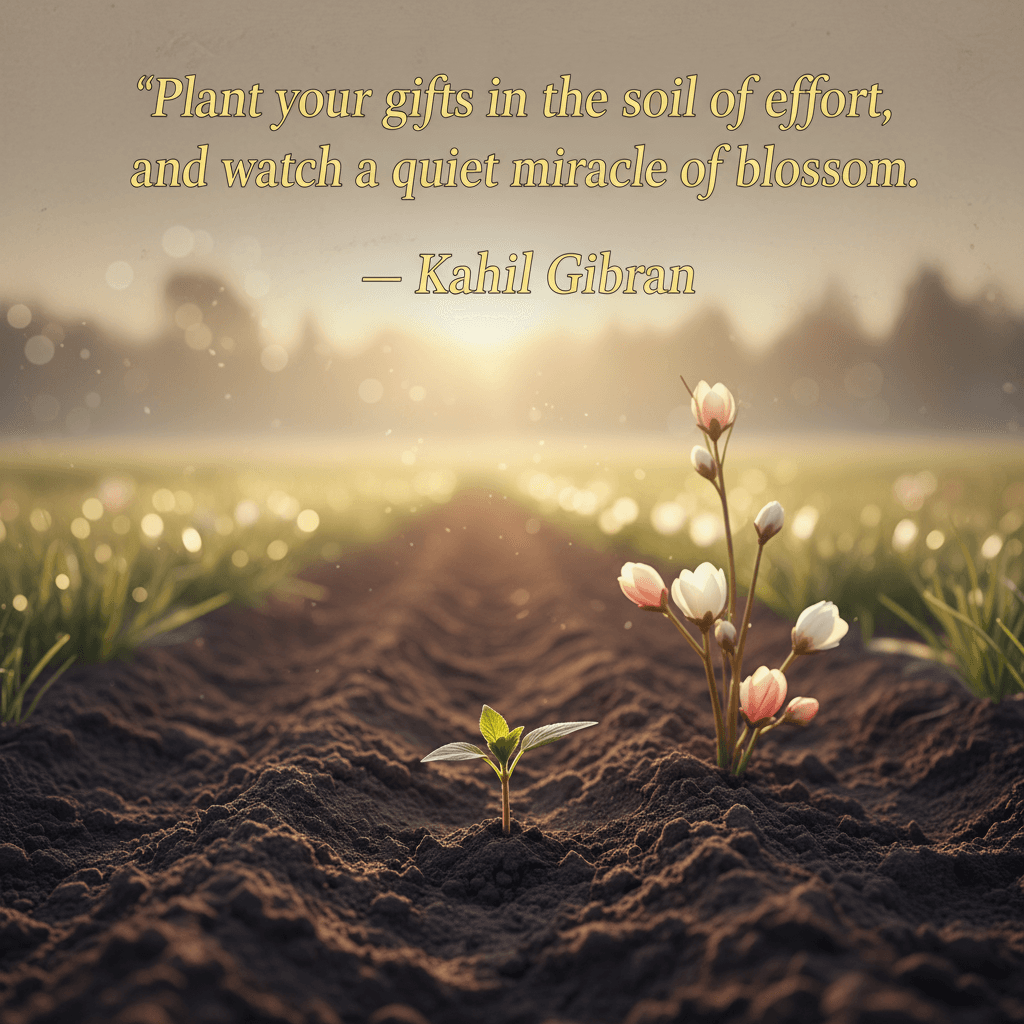Cultivating Gifts Through Effort's Quiet Miracle

Plant your gifts in the soil of effort, and watch a quiet miracle of blossom — Kahlil Gibran
Gibran's Garden: Talent Needs Tending
At the outset, Gibran's agrarian image frames talent as seed and effort as soil. Seeds hold possibility, but without loam, water, and sun, they remain dormant. His line echoes the orchard wisdom running through The Prophet (1923), where work dignifies the soul and turns capacity into contribution. By urging us to plant, he insists that gifts are not ornaments but responsibilities; potential must be buried before it can rise. Consequently, the act of planting becomes an ethical choice. Instead of waiting for ideal weather or effortless paths, we kneel in the dirt of practice, accept mess and uncertainty, and trust that concealment precedes emergence. In this way, humility and labor become the first nutrients of any authentic blossom.
Time and Patience: The Unhurried Bloom
In turn, the quiet miracle suggests a tempo of growth that resists spectacle. Peonies often take two to three years to flower, and orchards may not bear fruit for several seasons; yet when they do, the bounty arrives as if overnight. So it is with craft: invisible root work precedes visible bloom. Therefore, patience is not passive waiting but active stewardship. We prepare the bed, water regularly, and protect seedlings from frost, knowing that time amplifies small, consistent acts. This unhurried cadence counters the culture of instant results, reminding us that depth demands duration. When the blossom finally appears, it feels quiet precisely because the real drama has been unfolding underground all along.
Effort as Fertile Soil: Mindset and Grit
Moreover, psychology illuminates why sustained effort transforms raw talent. Carol Dweck's Mindset (2006) shows that a growth mindset reframes challenge as nutrient rather than threat, encouraging persistence through setbacks. Angela Duckworth's Grit (2016) further demonstrates that perseverance and passion for long-term goals predict achievement beyond initial aptitude. Alongside attitude, method matters. Research on deliberate practice, advanced by K. Anders Ericsson and later popularized in Peak (2016), finds that focused, feedback-rich effort rewires skill. Just as compost turns refuse into richness, targeted struggle converts errors into structure. Thus, Gibran's soil of effort is not generic hard work, but purposeful cultivation that nourishes roots rather than merely scuffing the surface.
Roots and Networks: Community as Mycorrhiza
Extending the metaphor, no plant grows alone; roots partner with fungal networks that share nutrients and signals. Suzanne Simard's studies (Nature, 1997) and her book Finding the Mother Tree (2021) reveal how forests redistribute resources to support weaker saplings. This living web mirrors mentorship, peer circles, and communities that quietly feed our growth. Consequently, tending our gifts includes tending our ties. We seek critique, trade insights, and reciprocate support, allowing the ecosystem to stabilize us through drought and shade. The blossom then becomes communal, not merely personal: a product of generosity moving through hidden channels, making individual effort more resilient and more humane.
Craft and Calling: Illustrative Blossoms
In practice, history’s makers show how buried labor yields visible beauty. Beethoven's surviving sketchbooks, analyzed by Gustav Nottebohm (1863), reveal relentless revision beneath seemingly effortless melodies. Marie Curie refined tons of pitchblende before announcing radium and polonium in 1898, work later detailed in Traité de Radioactivité (1910). Likewise, Georgia O'Keeffe's decades of studying form and color culminated in those unmistakable, austere flowers. These examples clarify Gibran's miracle: the public bloom appears sudden, yet the private tilling is years deep. By tracing their process notes, lab logs, and drafts, we glimpse the soil lines on their hands. The blossom is therefore less a stroke of fate than the harvest of disciplined devotion.
Cultivation Methods: Habits, Seasons, Rest
Ultimately, to plant gifts well, we design a garden of habits. Short, daily sessions keep soil moist; feedback trellises growth in the right direction; and scheduled rest serves as winter, when roots consolidate. Peak (Ericsson and Pool, 2016) underscores that recovery is integral to adaptation, not a luxury. At the same time, we compost failures by extracting lessons, track progress to witness slow gains, and align projects with seasons of energy. As these practices layer, effort becomes hospitable earth rather than grind. Then, without fanfare, the bud opens. The miracle stays quiet not because it is small, but because our steady tending has made the extraordinary feel natural.